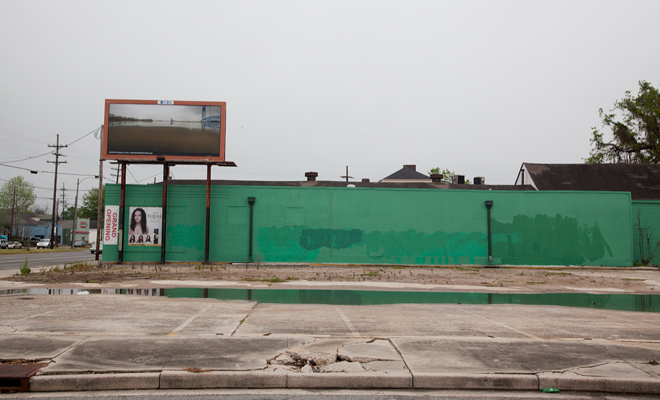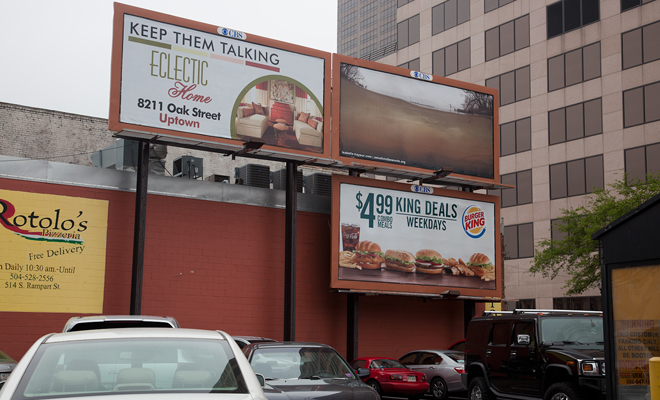Photoclines: Isabelle Hayeur’s Underworlds

View of Isabelle Hayeur's photograph, 9th Ward Levee, installed as a billboard at 4018 St. Claude Avenue in New Orleans.
Most of Isabelle Hayeur’s photographs follow the rule of thirds. A classic composition, seen frequently in landscape and architectural photography, the technique affords the eye an accessible amount of information with an easy means of traveling the image. But Hayeur’s latest photographs do not adopt the pastoral fields or abandoned industrial sites that have come to dominate contemporary photography. Rather, it is the splits between land and water that hold her gaze, splits that she captures both at the surface of the water and beneath it.
As part of her recent residency at A Studio in the Woods, Hayeur, a French-Canadian artist based in Montreal, came to Louisiana to continue her ongoing series of polluted and endangered waterways. Called Underworlds, this series began in the Florida Everglades in 2008. It is a record—part documentarian, part activist—of the strange and ethereal subsurface landscapes that marine environments such as rivers, canals, and lakes produce. Hayeur infiltrates these environments, typically the preserve only of their animal inhabitants, with an underwater camera to reveal what would rarely otherwise be seen. The resulting photographs straddle the lines we frequently forget exist, images that bring the hazy, murky—yet in many cases surprisingly beautiful—reality of these environments to the fore.
Scuba divers know well the thermocline, the physical line in the water where the heat from the sun’s rays disappears, below which the temperature immediately drops. Hayeur’s images exhibit much the same effect, almost Rothko-like. Due to particle suspensions in the water, the middle third of her images is frequently obscured, the palette muted and smeared as though run through a sieve. In the riverine settings she depicts, the quality of the water itself, clouded either by pollutants and additives or simply by its inability to be flushed and recharged as natural bodies of water crave, ranges from deep earth browns to sickly greens that cry out for relief. In those images where the water’s floor is visible, a floor that often occupies the bottom third of the frame, Hayeur captures objects that, in a muddy riverbed, would sooner be known by our hands and feet than by our eyes. Reeds, stones, pebbles, roots and shells appear in large, almost stark aspect, illustrating their role both in the local ecosystem (what flock of minnows wouldn’t want to hide in the forest of cypress roots?) and, in the case of cast-off trash, their insignificance in our own.
In southern Louisiana, the point is well-taken. During her residency at A Studio in the Woods, Hayeur spent six weeks photographing local bayous, lakes, and the Mississippi River. Her efforts only confirm much of what we have known for years: that our waterways are in no small danger, that human intervention and control has harmed them as much as it has helped, and that—particularly with respect to the wetlands—the resources devoted to restoring them pale in comparison to those we pour into maintaining the industrial infrastructure that poisons them.
Nevertheless, in revealing the submarine habitats that surround us and support life in this region, Hayeur offers a much-needed window not just onto the habitats themselves, but onto our varied forms of inattention that engender their neglect. These photographs act as their own thermocline, inviting us to consider what of our own mental riverbeds might need intervention against this political and environmental threat. In this sense, they might be best termed photoclines, compelling a physical shift in our attention that awakens and enlivens us, and restores our sense of connection with the land.
But the window of opportunity to undertake these tasks of restoration is short: matters of the long-term prospects for the Louisiana coast aside, the fate of Hayeur’s images is indeterminate. Currently reproduced in billboard format around New Orleans, they are guaranteed to be on view only through April. Demand for the advertising space will dictate whether they stay beyond that. The chance to see these visions is not to be missed, nor the chance to see something else deeper, and more rare, at the same time.

View of Isabelle Hayeur's photograph, Mississippi River, installed as a billboard at 500 South Rampart Street in New Orleans.
Editor's Note
Underworlds, by Isabelle Hayeur, can be seen at four locations in New Orleans: 500 North Jefferson Davis Parkway, 2000 South Claiborne Avenue, 500 South Rampart Street, and 4018 St. Claude Avenue.



